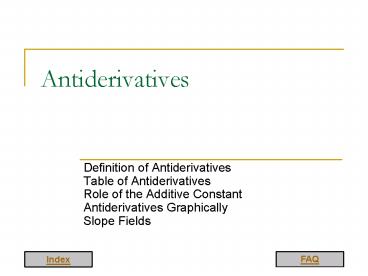Antiderivatives
1 / 7
Title: Antiderivatives
1
Antiderivatives
- Definition of AntiderivativesTable of
AntiderivativesRole of the Additive
ConstantAntiderivatives GraphicallySlope Fields
2
Antiderivative
Definition
A function F is an antiderivative of a function
f if Ff.
F
Theorem
Assume that f is continuous on an interval
(a,b). If F1 and F2 are both antiderivatives
of the function f on the interval (a,b), then
there is a constant C such that F1 F2 C.
f
Proof
Consider the function F F1 F2. By the
properties of F1 and F2, F F1 F2 f
f 0.
We conclude, by the Corollary to the Mean Value
Theorem, that F is a constant function.
F is an antiderivative of f
3
Table of Particular Antiderivatives
In the last and high-lighted formula above we
assume that F f and G g. The
coefficients a and b are numbers.
These rules give particular antiderivatives of
the listed functions. A general antiderivative
can be obtained by adding a constant to the above
given antiderivatives except in the case of the
function 1/x (see later remarks).
4
Computing Antiderivatives
Problem
Solution
5
Role of the Additive Constant
A consequence of the Mean Value Theorem is that
the general antiderivative of a function can
always be obtained by adding a constant to a
particular antiderivative.
Example
Antiderivatives of the function cos x are of
the form sin x C, where C is a constant.
The above reasoning does assume that the function
in question is everywhere differentiable. The
situation becomes more complicated if there are
singularities.
Example
This is often abbreviated by saying that the
general antiderivative of the function 1/x is
ln x C, where C is arbitrary constant. In
view of the above remark this is not accurate
because the constant C may depend on the sign
of x. This is due to the fact that the function
1/x is not continuous at x 0.
6
Antiderivatives Graphically
The general antiderivative of a function f is
of the form F C where F is a particular
antiderivative and C is a constant. The graphs
of the antiderivatives F C fill the whole
plane, i.e., if a point (x0,y0) of the plane is
given, then there is an antiderivative F C
whose graph contains the given point.
The condition (F C) f tells us that the
slope of the tangents of the graph of an
antiderivative F C are given by the function
f. Hence we may approximate graphs of
antiderivatives by forming a slope field defined
by the given function f.
- The slope field defined by a function f is
obtained by - placing a grid of points (xn,yn) on a viewing
rectangle in the plane, - computing the values f(xn) for all n,
- drawing short arrows at the points (xn,yn) with
slopes f(xn).
7
Slope Fields
Example
The figures below show two slope fields defined
by the function sin x. The graph of an
antiderivative passing through a given point
(x0,y0) on the grid can be approximated by
joining the arrows of the slope field together to
form a continuous curve. The figures below
illustrate the solution passing through the point
(0,-4). This is the graph of the function - cos
x 3.
Clearly, in the case of the function sin x, the
approximations of antiderivatives can be made as
precise as necessary by taking a dense enough
grid.































